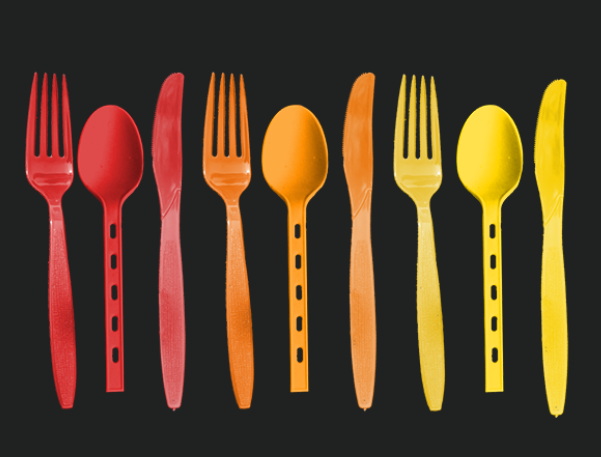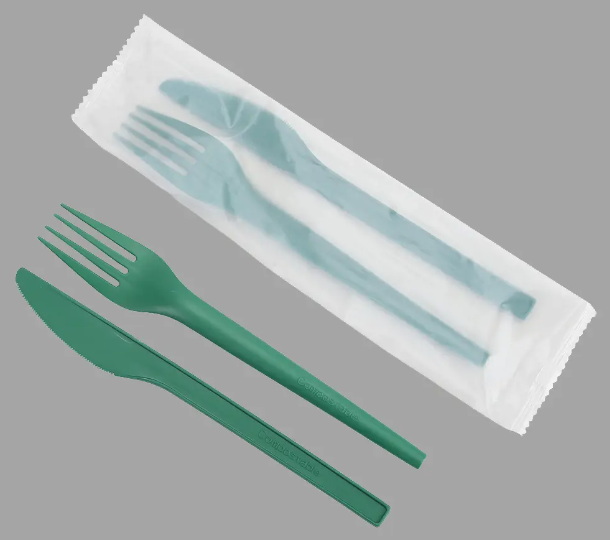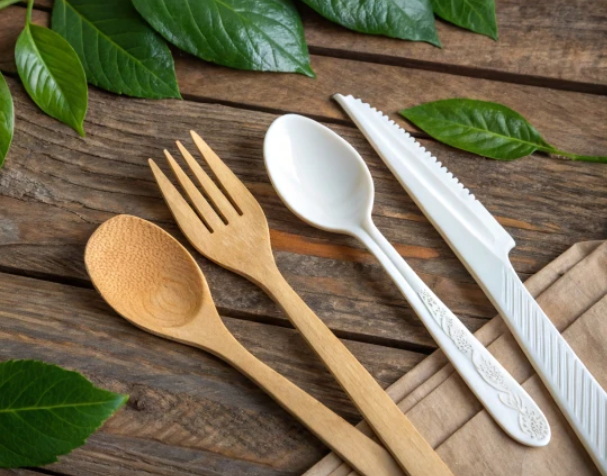
Content Menu
● Why Proper Disposal Matters
>> Environmental Impact
● How To Dispose of Plastic Cutlery
>> 1. General Disposal Guidelines
>> 2. Recycling Challenges
>> 3. Creative Ways to Repurpose Plastic Cutlery
>> 4. Compostable Alternatives
● Alternatives to Disposable Plastic Cutlery
>> 1. Reusable Cutlery
>> 2. Non-Plastic Disposable Options
>> 3. Edible Utensils
● Impact of Regulations on Plastic Cutlery
● Tips for Reducing Plastic Cutlery Waste
>> 1. Carry Reusable Utensils
>> 2. Say No to Disposable Utensils
>> 3. Support Eco-Friendly Businesses
>> 4. Educate Others
● Challenges in Transitioning Away From Plastic Cutlery
● Conclusion
● FAQs About Plastic Cutlery Disposal
>> 1. Can I recycle plastic cutlery?
>> 2. Are biodegradable plastic utensils better?
>> 3. What are the best alternatives to disposable plastic cutlery?
>> 4. Why can't small plastics like cutlery be recycled?
>> 5. How long does it take for plastic cutlery to decompose?
Plastic cutlery is a staple of modern convenience, commonly used for picnics, takeout meals, and large gatherings. While these utensils offer ease of use, their environmental impact is significant. Improper disposal of plastic cutlery contributes to pollution, harms ecosystems, and clogs landfills. This article explores how to properly dispose of plastic cutlery, alternatives to reduce waste, and actionable steps to minimize its environmental footprint.

Why Proper Disposal Matters
Plastic cutlery is typically made from polystyrene or polypropylene—materials that are non-biodegradable and difficult to recycle. When disposed of improperly, these items often end up in landfills or oceans, where they can persist for centuries. According to environmental studies, plastic cutlery can take up to 200 years to decompose under sunlight exposure. Without proper disposal methods, this waste poses a threat to wildlife and contributes to the growing issue of microplastic pollution.
Environmental Impact
The environmental consequences of disposable plastic cutlery are far-reaching:
- Marine Pollution: Small plastic items like forks and spoons can easily be swept into waterways, where they harm marine life. Animals often mistake these items for food, leading to ingestion and fatal blockages.
- Landfill Overflow: Plastic utensils occupy space in landfills without breaking down, contributing to long-term waste accumulation.
- Microplastic Formation: Over time, plastic cutlery breaks into smaller fragments called microplastics. These particles infiltrate soil and water systems, entering the food chain.
How To Dispose of Plastic Cutlery
1. General Disposal Guidelines
Most plastic cutlery is not recyclable due to its composition and size. As such:
- Place used plastic utensils in your regular garbage bin.
- Clean the utensils before disposal to prevent contamination.
2. Recycling Challenges
Recycling facilities face difficulties processing small plastic items like cutlery because they:
- Fall through sorting machines.
- Contaminate other recyclables.
- Require specialized equipment for proper handling.
If you're unsure whether your local recycling center accepts plastic cutlery, consult their guidelines or contact them directly.
3. Creative Ways to Repurpose Plastic Cutlery
Instead of throwing away plastic utensils, consider repurposing them:
- Gardening Tools: Use forks as mini rakes for planting seeds or loosening soil.
- DIY Projects: Create decorative art pieces or functional items like jewelry holders.
- Educational Crafts: Schools and community centers often use repurposed materials for art projects.
4. Compostable Alternatives
If you're using biodegradable or compostable plastic cutlery, ensure it's disposed of in a commercial composting facility rather than home compost bins. These facilities provide the high temperatures required for proper decomposition.
Alternatives to Disposable Plastic Cutlery
Reducing reliance on disposable plastic cutlery is one of the most effective ways to combat waste. Here are some sustainable alternatives:
1. Reusable Cutlery
Investing in reusable utensils made from stainless steel, glass, or ceramic is a long-term solution. These materials are durable, easy to clean, and eco-friendly.
2. Non-Plastic Disposable Options
Consider switching to disposable utensils made from natural materials:
- Bamboo: Lightweight and biodegradable.
- Wood: Sturdy and compostable.
- Bagasse (Sugarcane Fiber): A byproduct of sugar production that decomposes quickly.
3. Edible Utensils
Innovative edible cutlery made from ingredients like rice or wheat offers a zero-waste solution while adding novelty to meals.

Impact of Regulations on Plastic Cutlery
Governments worldwide are taking steps to reduce single-use plastics:
- In the European Union, a ban on single-use plastic items—including cutlery—came into effect in 2021.
- Canada has committed to phasing out single-use plastics by 2030.
- India has banned certain disposable plastics as part of its sustainability goals.
These regulations aim to encourage businesses and consumers to adopt greener alternatives while reducing environmental harm.
Tips for Reducing Plastic Cutlery Waste
1. Carry Reusable Utensils
Portable utensil sets are widely available and convenient for travel or dining out. Many sets include collapsible forks, spoons, knives, and even chopsticks.
2. Say No to Disposable Utensils
When ordering takeout or delivery meals, specify that you don't need disposable utensils. This simple step can significantly reduce waste over time.
3. Support Eco-Friendly Businesses
Choose restaurants and cafes that use sustainable packaging and biodegradable utensils. Supporting such businesses encourages broader adoption of environmentally friendly practices.
4. Educate Others
Spread awareness about the environmental impact of disposable plastics among friends and family. Encourage them to adopt sustainable habits like carrying reusable utensils.
Challenges in Transitioning Away From Plastic Cutlery
While switching away from disposable plastic cutlery is ideal for the environment, certain challenges exist:
1. Cost: Eco-friendly alternatives may be more expensive than traditional plastic options.
2. Availability: In some regions, sustainable materials may not be readily accessible.
3. Consumer Habits: Many people prioritize convenience over sustainability when choosing disposable items.
Addressing these challenges requires collective efforts from governments, businesses, and individuals.
Conclusion
Proper disposal of plastic cutlery is essential for reducing its environmental impact. While recycling options are limited due to technical challenges, repurposing used utensils and switching to sustainable alternatives can make a significant difference. By adopting eco-friendly habits—such as carrying reusable utensils or supporting green businesses—we can collectively contribute to a cleaner planet.
As governments implement stricter regulations on single-use plastics, consumers have an opportunity to lead by example in reducing waste. The transition away from disposable plastic cutlery may require effort but is ultimately beneficial for both the environment and future generations.

FAQs About Plastic Cutlery Disposal
1. Can I recycle plastic cutlery?
No, most recycling facilities do not accept plastic cutlery due to its small size and lightweight nature. It is best disposed of in general waste bins unless your local recycling center specifies otherwise.
2. Are biodegradable plastic utensils better?
Biodegradable plastics can be better than traditional plastics but require specific composting conditions for proper breakdown. Non-plastic alternatives like bamboo or wood are generally more eco-friendly because they decompose naturally without specialized facilities.
3. What are the best alternatives to disposable plastic cutlery?
Reusable utensils made from stainless steel or glass are ideal for long-term use. For disposables, materials like bamboo, wood pulp, or bagasse-based products offer sustainable options that decompose quickly without harming the environment.
4. Why can't small plastics like cutlery be recycled?
Their small size causes them to fall through sorting machines at recycling facilities, contaminating other recyclables and disrupting the process. Additionally, many facilities lack the equipment needed for processing such items efficiently.
5. How long does it take for plastic cutlery to decompose?
Plastic cutlery can take up to 200 years—or even longer—to photodegrade under sunlight exposure due to its chemical composition. Without sunlight (e.g., in landfills), decomposition takes significantly longer or may not occur at all.

















